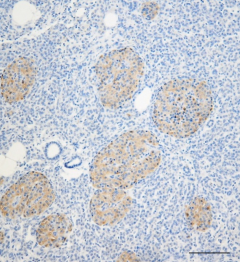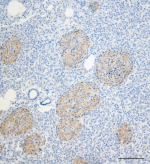- Clone
- MC.028.83.76.242 (See other available formats)
- Regulatory Status
- RUO
- Other Names
- Leucine-rich repeat serine/threonine-protein kinase 2, augmented in rheumatoid arthritis 17, AURA17, DARDARIN, PARK8, RIPK7, ROCO2
- Previously
-
Covance Catalog# SIG-39840
- Isotype
- Mouse IgG1, κ
- Ave. Rating
- Submit a Review
- Product Citations
- 2 publications

| Cat # | Size | Price | Quantity Check Availability | Save | ||
|---|---|---|---|---|---|---|
| 808201 | 100 µL | £78 | ||||
Leucine-rich repeat kinase 2 (LRRK2), is a member of the leucine-rich repeat kinase family. This protein also functions as a GTPase. Proteins with leucine-rich regions play a role in protein-protein interactions and mediate assembly of the cell's structural framework (cytoskeleton). Mutations in LRRK2 genes have been associated with late-onset Parkinson's disease.
Product DetailsProduct Details
- Verified Reactivity
- Human
- Antibody Type
- Monoclonal
- Host Species
- Mouse
- Immunogen
- This monoclonal antibody was raised against a peptide immunogen comprising amino acids 2069-2087 of the LRRK2 protein in mice that did not express endogenous LRRK2 protein.
- Formulation
- Phosphate-buffered solution.
- Preparation
- The antibody was purified by affinity chromatography.
- Concentration
- 1 mg/ml
- Storage & Handling
- This antibody should be handled aseptically as it is free of preservatives such as Sodium Azide. Store this antibody undiluted between 2°C and 8°C. Please note the storage condition for this antibody has been changed from -20°C to between 2°C and 8°C. You can also check the vial label or CoA to find the proper storage conditions.
- Application
-
IHC-P - Quality tested
Direct ELISA - Verified - Recommended Usage
-
Each lot of this antibody is quality control tested by formalin-fixed paraffin-embedded immunohistochemical staining. For immunohistochemistry, a concentration of 25 µg/mL is suggested. For Direct ELISA, a concentration range of 1.0 - 10 µg/mL is suggested. It is recommended that the reagent be titrated for optimal performance for each application.
- Application Notes
-
This antibody was generated with support from The Michael J. Fox Foundation. The Michael J. Fox Foundation is dedicated to finding a cure for Parkinson's disease through an aggressively funded research agenda and to ensuring the development of improved therapies for those living with Parkinson's today. To learn more about MJFF, please visit www.michaeljfox.org.
- Product Citations
-
- RRID
-
AB_2564739 (BioLegend Cat. No. 808201)
Antigen Details
- Structure
- This gene is a member of the leucine-rich repeat kinase family and is encoded by the PARK8 gene. The protein is present mainly in the cytoplasm but can be associated with the mitochondrial outer membrane.
- Distribution
-
Tissue distribution: Lung, Kidney, parathyroid gland, CNS
Cellular distribution: cytoplasm, mitochondrion, nucleus, endoplasmic reticulum, lysosome, Golgi apparatus, endosome - Function
- LRRK2 interacts with the C-terminal R2 RING finger domain of parkin. LRRK2 positively regulates autophagy through a calcium-dependent activation of the CaMKK/AMPK signaling pathway. Mutations in this gene have been associated with Parkinson disease.
- Biology Area
- Cell Biology, Mitochondrial Function, Neuroinflammation, Neuroscience, Neuroscience Cell Markers
- Molecular Family
- Mitochondrial Markers
- Antigen References
-
- Paisán-Ruíz C, et al. 2004. Neuron. 44(4):595-600.
- Alegre-Abarrategui J, et al. 2009. Hum. Mol. Genet. 18(21):4022-34.
- Gómez-Suaga P, et al. 2012. Hum. Mol. Genet. 21(3):511–25.
- Orenstein SJ, et al. 2013. Nat. Neurosci. 16(4):394–406.
- Cherra SJ, et al. 2013. Am. J. Pathol. 182(2):474–84.
- Gene ID
- 120892 View all products for this Gene ID
- UniProt
- View information about LRRK2 on UniProt.org
Related Pages & Pathways
Pages
Related FAQs
Other Formats
View All LRRK2 Reagents Request Custom Conjugation| Description | Clone | Applications |
|---|---|---|
| Purified anti-LRRK2 | MC.028.83.76.242 | IHC-P,Direct ELISA |
Customers Also Purchased


Compare Data Across All Formats
This data display is provided for general comparisons between formats.
Your actual data may vary due to variations in samples, target cells, instruments and their settings, staining conditions, and other factors.
If you need assistance with selecting the best format contact our expert technical support team.

 Login / Register
Login / Register 


















Follow Us